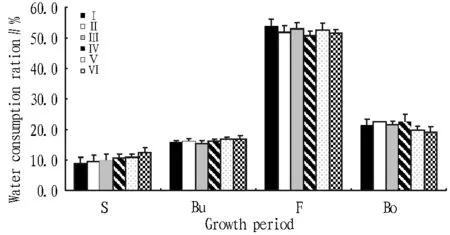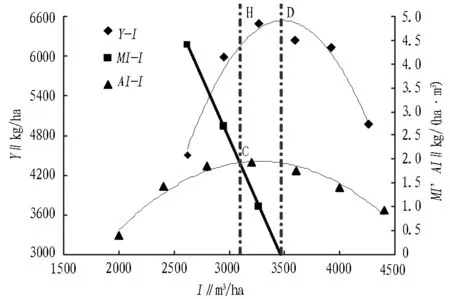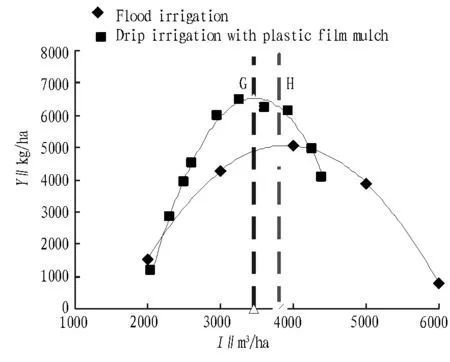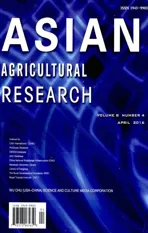Cotton’s Water Demand and Water-Saving Benefits under Drip Irrigation with Plastic Film Mulch
2016-01-11,,
, ,
1. General Station of Water and Soil Conversation and Eco-environmental Monitoring of Xinjiang, Urumqi 830000, China; 2. Institute of Soil and Fertilizer and Agricultural Sparing Water, Xinjiang Academy of Agricultural Sciences, Urumqi 830091, China
1 Introduction
The drip irrigation with plastic film mulch is the most efficient water-saving irrigation technique for Xinjiang oasis agriculture, and the water and salt transport law of cotton field under drip irrigation with plastic film mulch draws widespread concern of scholars. Domestic scholars have conducted in-depth studies on the soil and water movement and its influencing factors under drip irrigation as well as the factors that affect wetted material transport[1-8]. There has been significant progress in the studies on soil salt transport, distribution and accumulation of cotton field under drip irrigation with plastic film mulch[9-11]. Sun Linetal.[12]also predict the soil salinity trends of cotton field under long-term drip irrigation. Wang Youkeetal.[13]also discuss the water-saving and yield-increasing irrigation mode. The drip irrigation with plastic film mulch has changed the previous water movement law, and the crop’s water demand and irrigation system under ordinary irrigation can not be entirely same as that under drip irrigation with plastic film mulch. However, currently, there is still a shortage of studies on cotton’s water demand and water consumption, water-saving and yield-increasing benefit, and appropriate irrigation system under drip irrigation with plastic film mulch. Scholars have achieved some results on the study of cotton’s water demand and water consumption and irrigation system under drip irrigation with plastic film mulch in northern Xinjiang[14-15]. The studies on the crop’s water demand in southern Xinjiang are mainly based on ordinary irrigation, and the water demand calculation model for some crops has been established through long-term studies[16-17]. However, few studies are about the cotton’s water demand and irrigation system under drip irrigation with plastic film mulch. Liu Xinyongetal.[18]study the cotton’s water consumption and irrigation system under drip irrigation with plastic film mulch in southern Xinjiang, but it still can not meet the cotton cultivation and extension needs under drip irrigation with plastic film mulch in entire southern Xinjiang. Comprehensive understanding the cotton’s water demand and water consumption under drip irrigation with plastic film mulch, and making a comparative analysis of water use efficiency and water-saving benefits under different irrigation patterns, is of great significance to developing water-saving agriculture, strengthening intensive management of water resources, improving water use efficiency, and predicting cotton yield. However, in southern Xinjiang with water scarcity, it still lacks the studies on cotton’s water demand, irrigation system and cotton’s water production function under drip irrigation with plastic film mulch, and especially the water use efficiency and water-saving benefits under different irrigation patterns. Therefore, through the field plot experiment with different amounts of irrigation, this paper uses the dynamic water monitoring data and water balance theory to study the cotton’s water consumption at growth stage under drip irrigation with plastic film mulch in Tarim Irrigated Area, to determine the water balance and conversion relationship between various elements in cotton field under drip irrigation with plastic film mulch, and establish the quantitative relationship between cotton yield and amount of irrigation under drip irrigation with plastic film mulch and ordinary flood irrigation. This paper makes an analysis of water-saving benefits under drip irrigation with plastic film mulch in order to provide a theoretical basis for the scientific irrigation and rational allocation of limited water resources in Tarim Irrigated Area.
2 Materials and methods
2.1OverviewofthestudyareaThe experiment was carried out in Aksu Agroecosystem National Field Research Station of Chinese Academy of Sciences (40°37’N, 80°45’E) during 2005-2012. The study area has a warm temperate arid climate, with the annual average temperature of 11.2℃. Compared with the same latitude regions, the temperature is very high in summer but quite low in winter, and the spring and autumn temperature changes violently. The annual rainfall is 45.7 mm; the annual water surface evaporation is 2500 mm; the frost-free period is 207 d; the number of annual sunshine hours is 2940; the total annual solar radiation is 6000 MJ/m2. The soil is silt loam.
2.2ExperimentaldesignThe experiment uses the randomized plot design, and irrigation volume has six levels, namely 4265 m3/ha (Ⅰ), 3926 m3/ha (Ⅱ), 3600 m3/ha (Ⅲ), 3271 m3/ha (Ⅳ), 2947 m3/ha (Ⅴ), 2618 m3/ha (Ⅵ). Each treatment is repeated four times, and the plot area is 389.2 m2. The cotton variety for experiment is Zhongmian 49, and the spacing in the rows and spacing between rows use the wide and narrow row spacing configuration[(10 + 65 + 10 + 60) cm], namely 4 rows of cotton is planted under each film, with narrow row spacing of 10 cm, wide row spacing of 65 cm, film spacing of 60 cm and row spacing of 10 cm. It was planted on April 28, and 450 kg/ha of DAP was applied as basal fertilizer before planting. As to the irrigation during the whole growth period, it uses drip irrigation mode, and the drip irrigation belt is in the middle of wide rows. The drip irrigation is conducted every 7 days, and the irrigation lasts for 7-11 h. It was irrigated for the first time on June 24 (bud stage), and it was irrigated for a total of 10 times. During the irrigation for the third time to sixth time, 450 kg/ha of urea and 150 kg/ha of potassium dihydrogen phosphate are applied.
2.3Researchmethods
2.3.1Soil moisture observation. Under different moisture treatment, the neutron tube is laid in the wide cotton rows, narrow rows and between film, respectively, and the neutron moisture meter (CNC503DR) is used to measure the 0-20, 20-40, 40-60, 60-80 and 80-100 cm soil water content. It is measured once every 2 d, and it is tested around drip irrigation. In order to solve the inaccuracy of neutron instrument in measuring surface soil moisture, the drying method is used for neutron instrument calibration.
2.3.2Evapotranspiration of reference crop (ET0). Using the Penman-Monteith equation recommended by FAO (Smith, 1991), we calculate the evapotranspiration of reference crop (ET0)[19]:
(1)
whereET0is the evapotranspiration of reference crop (mm);Rnis the net radiation of crop surface[MJ/(m2·d)];Gis the soil heat flux[MJ/(m2·d)];Tis the daily average temperature (℃);u2is 2 m high average daily wind speed (m/s);ea-edis the saturated water vapor pressure (kPa); Δ is the slope of saturated water pressure-temperature curve (kPa/℃);γis the psychrometric constant (kPa/℃).
According to the annual meteorological data of Aksu Research Station, we calculate the evapotranspiration of reference crop (ET0) by the above equation.
2.3.3Cotton’s water demand (ETc) and crop coefficient (Kc) under drip irrigation with plastic film mulch. The mathematical model between cotton’s water demand and its influencing factors is as follows:
ETc=Kc×ET0
(2)
whereETcis crop’s water demand (mm);ET0is the evapotranspiration of reference crop (mm);Kcis the crop coefficient.
First, we calculateET0, and then measureETcin the full wet soil conditions. The ratio of the two is the cotton coefficientKcunder drip irrigation with plastic film mulch.
2.3.4Cotton’s water consumption under drip irrigation with plastic film mulch. According to the field water balance principle[20], the simplified formula of cotton field water balance under drip irrigation with plastic film mulch is as follows:
ET=I-(W2-W1)-BW
(3)
whereETis cotton’s water consumption (mm);W1is the 100 cm soil water storage at the beginning of period (mm);W2is the 100 cm soil water storage at the end of period (mm);Iis the irrigation amount (mm);BWis the water exchange capacity under root layer (100 cm) (mm).
By equation (3), we calculate cotton’s water consumption; by Darcy’s law, we calculate the root layer fluxes.
2.3.5Data processing. One-way ANOVA is used to process data. If ANOVA results are significant, then the least significant difference (LSD) method is used for pairwise multiple comparison. All statistical analyses are completed by Excel and SPPS 13.0.
3 Results and analysis
3.1Cotton’swaterconsumptionandwaterconsumptionruleunderdripirrigationwithplasticfilmmulchFig. 1 shows that drip irrigation has a significant impact on cotton’s water consumption, and with decreasing drip irrigation, cotton’s total water consumption is reduced. Under each treatment, cotton’s water consumption is highest at blossoming and boll-forming stage, followed by the consumption at bud stage, and the consumption is low at seedling stage and boll-opening stage. There is no significant difference in cotton’s daily water consumption degree at seedling stage between different treatments, with value of 1.2-1.3 mm/d; after bud stage, the daily water consumption degree increases with increasing drip irrigation; at bud stage, the cotton’s daily water consumption degree under various treatments is 2.5-3.3 mm/d; after blossoming and boll-forming stage, the daily water consumption degree peaks, with value of 3.7-5.5 mm/d; at boll-opening stage, it decreases to about 1.4-2.2 mm/d. Obviously, the blossoming and boll-forming stage of cotton under drip irrigation with plastic film mulch is the stage with the highest water consumption degree in its growth period, and the water consumption accounts for 50% of total water consumption in whole growth period; the water consumption degree is lower at boll-opening stage, seedling stage and boll-opening stage. As can be seen from Fig. 2 there is a significant difference in the share of the water consumption in total water consumption (modulus coefficient) between different treatments; the share is smallest at seedling stage, reaching 8.9%-12.5%; the share is largest at blossoming and boll-forming stage, reaching 51.6%-53.8%; it is 15.4%-16.8% at bud stage and 19.1%-22.5% at boll-opening stage, but there is no significant difference between treatments. It indicates that the drip irrigation only affects the cotton’s water consumption, and does not affect the share of water consumption at each stage.

Note: Different lowercase letters indicate significant differences between treatments (P<0 .05), the sane as below.S: Seedling stage; Bu: Budding stage; F: Floweringand bolling stage; Bo: Boll opening stage; W: Whole growth period.The same below.Fig.1 Cotton’s water consumption at different growth stages under different water treatments

Fig.2 Share of cotton’s water consumption in total water consumption between different treatments at various growth stagesUnit:%
3.2Cotton’swaterdemandandwaterdemandruleunderdripirrigationwithplasticfilmmulchAs can be seen from Table 1, cotton’s water demand under drip irrigation with plastic film mulch in the whole growth period is 543.2 mm. At different growth stages, there are significant differences in water demand. The water demand (54.4 mm) is lowest at seedling stage, 10% of total water demand in the growth period, and the water demand intensity is 1.3 mm/d; the water demand (288 mm) is highest at blossoming and boll-forming stage, 53% of total water demand in the growth period, and the water demand intensity is 4.7 mm/d; the water demand is 83.5 mm at bud stage, 15.4% of total water demand in the growth period, and the water demand intensity is
Table1Cotton’swaterdemandandrulesunderdripirrigationwithplasticfilmmulch

Growthperiodmonth-dayNumberofdaysdReferencecropevapotranspirationmmCropcoefficientWaterdemandmmWaterdemandintensitymm/dModuluscoefficient%Seedlingstage(04-25-06-08)43251.9±7.0a0.22±0.003a54.4±1.4a1.3±0.03a10.0±2.0aBudstage(06-08-07-08)30186.0±6.0b0.45±0.010b83.5±1.7b2.8±0.06b15.4±1.0aBlossomingandboll-formingstage(07-08-09-07)61315.7±4.5c0.91±0.010c288.0±4.3c4.7±0.07c53.0±2.0aBoll-openingstage(09-07-11-07)60139.3±6.1d0.84±0.03d117.3±3.1d1.9±0.05d21.6±1.2aWholegrowthperiod194892.90.61543.22.7100.0
2.8 mm/d; the water demand is 117.3 mm at boll-opening stage, 21.6% of total water demand in the growth period, and the water demand intensity is 1.9 mm/d.
3.3Cotton’swaterproductionfunctionunderdripirrigationwithplasticfilmmulchThe relationship between seed cotton yield under drip irrigation with plastic film mulch (Y) and drip irrigation amount in the growth period (I) is shown in Fig. 3. Through the regression analysis, it is found that there is a second-degree parabolic relationship between the two:
Y=-0.0026I2+18.015I-24845 (R2=0.9592,n=6)
(1)
To analyze the effect of irrigation, we introduce two basic concepts, namely average irrigation yield (AI) and marginal irrigation yield (MI). We defineAIas the average yield per unit of irrigation amount[21](namely irrigation water use efficiency), and defineMIas the additional yield by increasing certain units of irrigation amount. It is the first-order derivative ofY-Irelationship, and the unit ofAIandMIis kg/(ha·m3).
MI=dY/dI=18.015-0.0052I
(2)
AI=Y/I=18.015-0.0026I-(24845/I)
(3)
Fig. 3 shows that three curves have two important turning points dividingY-Icurve into three sections. (i) The first point is the intersection point (C) ofMI-Icurve andAI-Icurve, the highest point of average yield curve, and the marginal yield at this point is equal to the average yield; the maximum irrigation water use efficiency is 1.941 kg/ha·m3, and the corresponding drip irrigation is 3091 m3/ha. (ii) The second point is the highest point (D) ofY-Icurve, and the marginal yieldMIat this point is zero. The maximum yield is 6360 kg/ha, the drip irrigation amount is 3464 m3/ha, and the irrigation water use efficiency is 1.836 kg/(ha·m3). The first section of curve is from original point to pointD, the marginal yield is greater than the average yield, and the growth rate of yield is higher than that of irrigation amount. It is the cotton water scarcity area, and the increase of irrigation amount in this section will significantly increase yield, so it is necessary to increase water input as long as there is enough water. The second section is fromCtoD, and the marginal yield is greater than zero, but less than the average yield. The growth rate of yield is lower than that of irrigation amount, and it is the water-deficient and water-regulatory area. The adjusted drip irrigation amount is 3091-3464 m3/ha, and when drip irrigation amount reaches 3464 m3/ha, the yield is highest. The third section is afterD, and the marginal yield is less than zero. The yield decreases with the increasing irrigation amount, and it is the wasteful irrigation area.

Fig.3 The relationship between irrigation amount and cotton yield, average yield or marginal yield under drip irrigation with plastic film mulch
3.4Water-savingbenefitsofcottonfieldunderdripirrigationwithplasticfilmmulchUnder drip irrigation with plastic film mulch and ordinary flood irrigation, the relationship between cotton yield and irrigation amount is shown in Fig. 4, and through regression analysis, it is found that there is a second-degree parabolic relationship. The relationship between cotton yield under drip irrigation with plastic film mulch and drip irrigation amount is shown in equation (1). The relationship between cotton yield under ordinary flood irrigation and irrigation amount is as follows:
Y=-0.000973I2+7.5986I-9761.7 (R2=0.9672,n=6)
(4)
As can be seen from Fig. 4, when the irrigation amount is less than 3464 m3/ha, the cotton yield under both irrigation modes increases with the increasing irrigation amount, the cotton yield under drip irrigation with plastic film mulch is greater than under ordinary flood irrigation, indicating that the sensitivity of cotton to irrigation water under drip irrigation with plastic film mulch is greater than under ordinary flood irrigation. When the irrigation amount is increased to 3464 m3/ha (G), the cotton yield (6360 kg/ha) peaks under drip irrigation with plastic film mulch, and the irrigation water use efficiency is 1.836 kg/(ha·m3). At this point, the cotton yield under ordinary flood irrigation is 4885 kg/ha, and irrigation water use efficiency is 1.410 kg/(ha·m3). The yield increases by 30.2% under drip irrigation with plastic film mulch, and irrigation water use efficiency increases by 30.2%. When the irrigation amount is 3464-3905 m3/ha, the cotton yield under drip irrigation with plastic film mulch will decrease with increasing irrigation amount, while the cotton yield under the ordinary flood irrigation will continue to increase with the increasing irrigation amount. When the irrigation amount increases to 3905 m3/ha (H), the cotton yield under the ordinary flood irrigation reaches the maximum of 5074 kg/ha, and the irrigation water use efficiency is 1.299 kg/(ha·m3). When the cotton yield under drip irrigation with plastic film mulch is equal to the maximum cotton yield under the ordinary flood irrigation, the drip irrigation amount is 2761m3/ha, and the irrigation water use efficiency is 1.838 kg/(ha·m3), saving 29.3% of water compared with the ordinary flood irrigation. When the irrigation amount is greater than 3905 m3/ha, the cotton yield under two irrigation modes will decrease with the increasing irrigation amount. When the cotton yield under two irrigation modes reaches maximum, drip irrigation with plastic film mulch cotton will save 11.3% of water, increase 25.3% of production and improve 41.3% of irrigation water use efficiency compared with the ordinary flood irrigation.

Fig.4 Relationship between drip irrigation amount and cotton yield under different irrigation modes
4 Conclusions and discussions
The water demand of cotton under drip irrigation with plastic film mulch in the whole growth period is 543 mm in Tarim Irrigated Area; the water demand is lowest at seedling stage, accounting for 10% of total water demand in the growth period; the water demand is highest at blossoming and boll-forming stage, accounting for 53%; the water demand at bud stage and boll-opening stage accounts for 15.4% and 21.6%, respectively. Under different drip irrigation amount, there is a difference between cotton’s actual water consumption and water demand, showing different levels of profit and loss. When the drip irrigation amount is 3600 m3/ha, the water supply and demand are balanced. The drip irrigation amount directly affects the cotton yield and irrigation water use efficiency, and there is a second-degree parabolic relationship, following law of diminishing returns. However, the highest point of yield is not consistent with that of irrigation water use efficiency, while the drip irrigation amount when the irrigation water use efficiency is highest is lower than the drip irrigation amount when the yield is highest, so there is contradiction between saving water and increasing production. From the perspective of saving water, when the drip irrigation amount is 3091 m3/ha, the irrigation water use efficiency can be highest, but the cotton yield at this point is 5.7% lower than the highest yield. To obtain maximum yield, the drip irrigation amount should be 3464 m3/ha. When the drip irrigation amount is less than 3091 m3/ha, it is the cotton water scarcity area under drip irrigation with plastic film mulch, and it is necessary to increase irrigation if there is enough water; when the drip irrigation amount is 3091-3464 m3/ha, it is the water-deficient and water-regulatory area; when the drip irrigation amount is more than 3464 m3/ha, the yield will decrease with the increasing drip irrigation amount, and it is the wasteful irrigation area. Under the same management mode, the highest cotton yield under drip irrigation with plastic film mulch is higher than under the ordinary flood irrigation, and when both modes achieve the highest yield, the drip irrigation with plastic film mulch cotton will save 11.3% of water, increase 25.3% of production and improve 41.3% of irrigation water use efficiency compared with the ordinary flood irrigation. Under the same amount of irrigation, the yield increases by 30.2% and irrigation water use efficiency increases by 30.2 % under drip irrigation with plastic film mulch, when compared with the ordinary flood irrigation. Under the same yield, drip irrigation with plastic film mulch will save 29.3% of water and increase 41.5% of irrigation water use efficiency compared with the ordinary flood irrigation, indicating that at the current water use conditions and current cotton yield level under the ordinary flood irrigation, using the drip irrigation with plastic film mulch to develop water-saving agriculture has huge yield potential, and can greatly improve the irrigation water use efficiency. From the perspective of sustainable development, it is necessary to explore the environmental effects and soil salinity trends under drip irrigation with plastic film mulch, establish the technical suitability evaluation indicators for drip irrigation with plastic film mulch, and build the ecological security of water-saving agriculture and sustainability assessment mechanism in the arid area of oasis, which is the fundamental requirement of sustainable development of water-saving agriculture in Xinjiang and the northwestern arid areas.
[1] LI Y, WANG WY, WANG QJ,etal. One-dimensional water and salt transport induced by temperature gradient[J].Transactions of the Chinese Society of Agricultural Engineering,2002,18(6):4-8.(in Chinese).
[2] WANG XP, LI XR, KANG ES. Experimental study on soil water and salt transport under drip irrigation in arid desert zone[J]. Agricultural Research in the Arid Areas,2002,20(3):44-48. (in Chinese).
[3] WANG QJ, WANG WY, WANG ZR,etal. Determination of technique parameters for saline-alkali soil through drip irrigation under film[J]. Transactions of the Chinese Society of Agricultural Engineering, 2001,17(2):47-50.(in Chinese).
[4] LV DQ, WANG QJ, WANG WY,etal. Factors affecting soil water movement and solute transport for film drip irrigation[J]. Acta Pedologica Sinica,2002,39(6):794-801.(in Chinese).
[5] ZHANG Q, LI GY, CHAI FJ. Effect of mulched drip irrigation frequency on soil salt regime and cotton growth[J]. Journal of Hydraulic Engineering,2004,35(9):123-126.(in Chinese).
[6] LI MS, KANG SZ, SUN HY. Relationships between dripper discharge and soil wetting pattern for drip irrigation[J].Transactions of the Chinese Society of Agricultural Engineering,2006,22(4):32-35.(in Chinese).
[7] WAN SM, HU SL, ZHAI YL. Studies on the dynamic change of soil water of cotton with drip irrigation[J]. Research of Soil and Water Conservation,2007,14(1):90-91.(in Chinese).
[8] YAN YY, LIN XH. Effects of irrigation modes on soil hydraulic properties[J].Research of Soil and Water Conservation, 2011,18(4):160-165.(in Chinese).
[9] WEI GH, DONG XG, YANG PN,etal. Study on soil salt movement in drip irrigation of cotton under the plastic mulch[J].Research of Soil and Water Conservation, 2009,6(6):162-166.(in Chinese).
[10] GE PF, HUDAN TMEB, WU ZG,etal. Research on soil salt accumulation influence by the years of covered cotton under drip irrigation[J].Research of Soil and Water Conservation, 2010,17(5):118-122.(in Chinese).
[11] ZHAO CY, YAN YY, LI JY,etal. Distributed characteristics of soil water-salt of cotton field under drip irrigation under mulching in Tarim Irrigated Area[J]. Arid Land Geography,2009,32(6):892-898.(in Chinese).
[12] SUN L, LUO Y. Study on the evolution trends of soil salinity in cotton field under long-term drip irrigation[J].Research of Soil and Water Conservation, 2013,20(1):186-192.(in Chinese).
[13] WANG YK, LV W, WANG DX,etal. Optimal model research of water-saving and production-increasing irrigation[J].Research of Soil and Water Conservation, 2006,13(2):153-153.(in Chinese).
[14] CAI HJ, SHAO GC.Water demand and irrigation scheduling of drip irrigation for cotton under plastic mulch[J].Journal of Hydraulic Engineering,2002(11):119-123.(in Chinese).
[15] MU CY, MA FY, ZHENG XR,etal. Simulation of evapotranspiration under the condition of drip irrigation with plastic film mulching in cotton field[J]. Transactions of the Chinese Society of Agricultural Engineering, 2005,21(4):25-29.(in Chinese).
[16] HU SJ, AINIWAER WME, SONG YD,etal.Calculation model of field evapotranspiration for cotton crop[J]. Arid Zone Research,2001,18(1):40-42.(in Chinese).
[17] HU SJ, WANG JL, SONG YD. Calculation model of the evapotranspiration from the cotton fields in the Aral irrigation area, Xinjiang[J].Arid Land Geography,2002,25(3):241-244.(in Chinese).
[18] LIU XY, TIAN CY, MA YJ,etal. Water consumption characteristics and scheduling of drip irrigation under plastic film for cotton in south Xinjiang[J].Agricultural Research in the Arid Areas,2006,24(1):108-112.(in Chinese).
[19]SMITH M. Report on the expert consultation on revision of FAO methodologies for crop water requirement[R]. Rome: FAO,1991.
[20] ZHAO JB, XU ZL, ZHONG ZZ,etal. On water balance of upland fields in northern China[M].Beijing: China Agriculture Press ,2000.(in Chinese).
[21] HU SJ, ZHOU HF, SONG YD,etal. Experimental study on optimal irrigation regime for high-yield and water-saving for cotton in Weiganhe River Irrigation Area[J].Journal of Irrigation and Drainage,2000,19(4):25-29.(in Chinese).
杂志排行
Asian Agricultural Research的其它文章
- Technological Innovation Characteristics and Capacity Enhancement Ways for the Agricultural Science and Technology Enterprises in Beijing City
- A Study of Current Land Use in the Urban Area of Ma’anshan City
- Survey and Evaluation of Reserve Arable Land Resources in Xinjiang’s Makit County
- Fruit Production Distribution and Adjustment Strategies under the Constraint of Grain Security
- The Influencing Factors and Inter-Group Differences for Urban Residents’ Behavior of Consuming Edible Vegetable Oil
- Economic Effect of China’s Rural Financial Market Growth during 1952-2013
